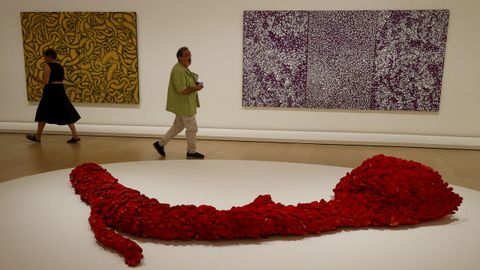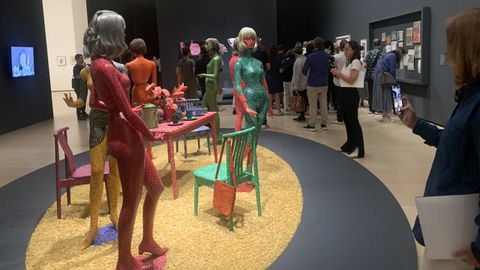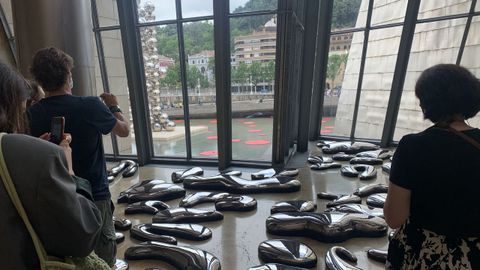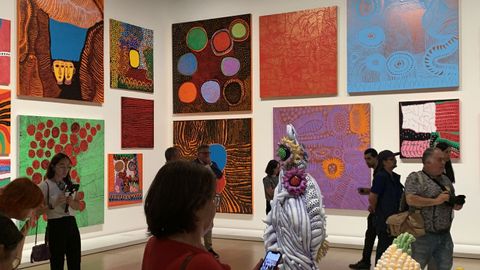The Guggenheim Museum in Bilbao is opening a major retrospective of the long-lived Japanese artist
A long history Yayoi Kusama — born in Matsumoto, Japan, in 1929, has accumulated nine decades of work — is a story of survival, struggle and improvement, self-belief and, finally, from the margins, achieving almost unexpected success. Since she was a child, she had to fight against her own destiny. Born into a high-class family attached to social conventions, his future depended on a well-chosen marriage.

One of the exhibition rooms of Kusama, one of the most popular living artists on the international scene, with the canvases “Obsession with Sex” (1992) and “Images of Human Beings” (1987), an example of her fondness for the structure of grids and dots. Below “Sewn Flower” (1980), a sculpture made of cotton, gloves and fabric. Author: Louis Fabric | eff
But she always wanted to paint, despite her mother destroying her prints and taking away her pencils. To this disturbance she added the tensions arising from the failure of the marriage in the air at home and the trauma caused by having to see her father with his conquests, since her mother had forced her to follow and spy on him. In the midst of that calamity, Kusama clung to her notebooks and her paintings, escaping reality, entering the endless liberator of the couch and flower fields of a prosperous family business. His earliest works refer to petals, seeds, plants that evoke a formation close to traditional Japanese classical art.
Your decision is firm. But she lives in a conservative, male-dominated country where she doesn’t belong. He starts thinking about leaving. By chance, in a book, she came across floral canvases by the American artist Georgia O’Keeffe, with whom she identifies. He also writes him a letter, asks for advice, sends him samples of his drawings. To her surprise, he answered her and, despite encouraging her to persevere, somehow dissuaded her from going to America: she was sequestered at her ranch in Santa Fe, he could hardly help her, and the script remained hostile to progress. .a woman in the world of art.

Visitors around the painting “Endless Networks” (2007), measuring 2.9 x 5.5 meters. Author: Louis Fabric | eff
For Kusama, it was an incentive. That plane trip in 1957 also opened his mind. The vision of an endless ocean from the air, a sea of clouds, marked his imagination. New York was his goal. But things were not easy. He was even starving. He was arriving at a place where trends were settling, at a time when abstract expressionism reigned supreme. He tried, though he ran into a wall again and again: art was a white man’s business. They hardly took her seriously. This contempt increased her mental breakdowns, leading to depression and suicide attempts. But Kusama is a born survivor.

Visitors view the installation “Self-Erase” (1966-1974), with interconnected dot puppets and furniture. Author:
Almost seventy years have passed and now it is a mass phenomenon, a brand that all museums on the planet want to boast about. In that zenith, in that hand-won glory, especially from the 90s, as a cultural icon of the 21st century, she is presented in a major retrospective that opens this Tuesday at the Guggenheim in Bilbao, Yayoi Kusama: 1945 to the Present, a project promoted by the M+ museum from Hong Kong in collaboration with the Basque institution and sponsored by Iberdrola. Curated by Doryun Chong and Mika Yoshitake, with the support of Lucía Aguirre, the ambition allows one to get a precise idea of the artist’s rich and distinctive universe.

Kusama’s “clouds” made of stainless steel; in the background, polka dots decorate the Guggenheim Pond in a marketing campaign. Author:
Through almost two hundred works, including paintings, sculptures, performancesmoving images, installations and archival materials, the exhibition takes a tour of his entire work, which is also an adventure parallel to the history of 20th century culture, of course, with its havens and intersections considering many of Kusama’s pioneering initiatives.

An exhibition room that includes Kusama’s latest works. Author:
Beyond her popular moles, and with the clairvoyance that comes with time, it is now easy to understand the depth of her art and the scope of her approaches, from the radical nature of her personality and her independence. “Subconscious and psychosomatic feelings are the basis of my sculptures and my paintings,” the artist admits in the documentary Kusama: Endless, to insist: «My work is based on translating my psychological problems into art». Because for her, in addition to being a social weapon —in favor of equality, peace—, her work is a tool of resistance and a therapeutic exercise, which, in her maturity —where the explosion of colors takes center stage—, she wants to extend it to others in order to achieve a better , a calmer and brighter world, turning his work into a great anthem of love and life.
From being kicked out of the Venice Biennale to representing his country
Life for Kusama was a path full of thorns, but also a path of transformation and redemption. At the age of 94, he is now known as an eminence, recognized by the museum in the once hated city of Matsumoto, with his work highly regarded throughout the world. She doesn’t stop. For decades, he lived in a Japanese psychiatric institution that advocates treating patients with art. And every day he goes out to work in his studio, with his team of collaborators, although the pandemic has changed his habits, so he sometimes paints in his room in smaller formats.

A visitor photographs Kusama’s “Pumpkins” (1998-2000). Author:
It’s been a long time since she was kicked out of the 1966 Venice Biennale, where she exhibited her installation of metal spheres—like mirrors that reflect I— Narcissus garden. He ended up selling each ball for two dollars in a subversive statement about the value of art. In 1993, shortly after her figure was rehabilitated, she was invited to represent her country at the same Italian fair that had humiliated her.

Detail of the work «Let’s see the flowers that bloom in the sky; With them I talked about love» (2021), one of his latest soft sculptures made of stuffed and sewn fabric. Author: Louis Fabric | eff
His talent and stubbornness turned a story of disdain and oblivion in which he saw — and condemned — artists like Oldenburg (the soft sculptures) and Warhol (the wallpaper on which he exhibited art) triumphing in appropriating his innovative ideas. image reproduction); The same thing happened with the mirrored rooms he created to take the repetition of his dots and light motifs to infinity.
This magnificent spectacle that comes to Bilbao as a great opportunity for spectators has had more than 280,000 visits at the young M+ Museum in Hong Kong. And there will be no more roaming.
Source: La Vozde Galicia
I am David Miller, a highly experienced news reporter and author for 24 Instant News. I specialize in opinion pieces and have written extensively on current events, politics, social issues, and more. My writing has been featured in major publications such as The New York Times, The Guardian, and BBC News. I strive to be fair-minded while also producing thought-provoking content that encourages readers to engage with the topics I discuss.







